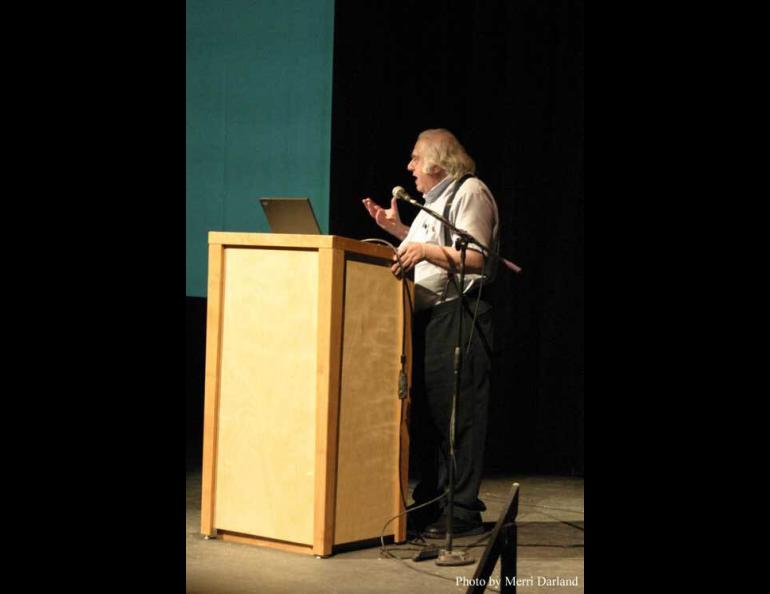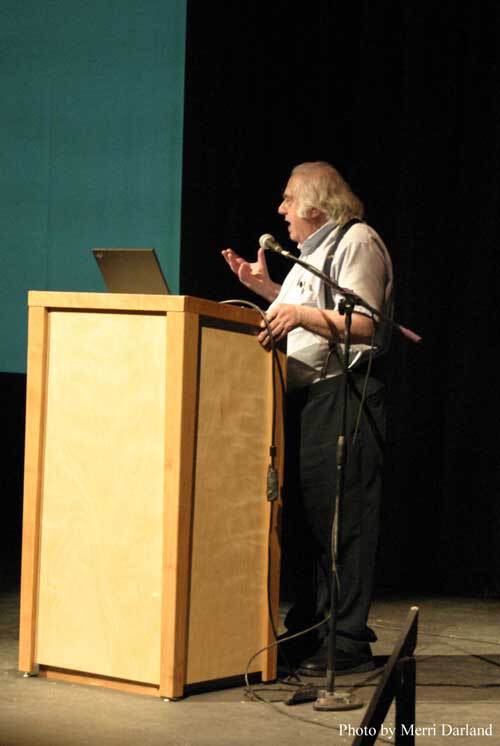
Peak oil pundit visits Alaska
“Thirty years from now, oil will be little used as a source of energy,” Kenneth Deffeyes told a crowd at the University of Alaska Fairbanks recently. “Our grandchildren will say, ‘you burned it? All those beautiful molecules? You burned it?’”
According to Deffeyes, a hard-rock geologist and professor emeritus at Princeton University, the world’s oil supply peaked on December 16, 2005, which means we’ve now removed and produced half of the oil that’s there to be sucked out. And what does that mean?
Increasing levels of chaos, he said. When the demands put on a system approach the system’s maximum output, things go a little crazy.
“We are close to the capacity of the system right now, so little things like hurricanes in the Gulf of Mexico can cause wild fluctuations,” he said. “Price volatility is on us in a big way.”
In his book, “The Long Emergency,” James Howard Kunstler wrote of the event that Deffeyes said happened last December: “At absolute peak, there will still be plenty of oil left in the ground—in fact, half of the oil that ever existed—but it will be the half that is deeper down, harder and costlier to extract, sitting under harsh and remote parts of the world, owned in some cases by people with a grudge against the United States, and this remaining oil will be contested by everyone.”
An animated speaker with an encyclopedic knowledge of everything to do with oil (he worked for Shell Oil, is a professor at Princeton and has written two books on the subject of reaching the peak of oil production), Deffeyes was on an Alaska tour that took him from Fairbanks to Anchorage to Palmer to Juneau. He said that the time for foresight has passed.
“We could have had a soft landing if we would have listened to Jimmy Carter and put his alternative energy plans in place,” he said, “but we’ve driven off the cliff.”
That cliff, according to Deffeyes, is reaching the oil peak without having solid plans for replacing the amazing substance that heats many American houses, fuels our cars, and wraps our sandwiches.
Not every oil expert agrees we’ve driven off that cliff. Daniel Yergin is chairman of Cambridge Energy Research Associates and author of “The Prize: the Epic Quest for Oil, Money and Power.” He wrote a The Washington Post editorial column in July 2005 in which he said our capacity to produce oil will grow until at least 2010, due in part to advances in technology that allow more oil recovery in Canada, Kazakhstan, Brazil, Azerbaijan, Angola, Russia, Saudi Arabia, Nigeria, Algeria and Libya.
“As skills improve, output from many producing regions will be much greater than anticipated,” Yergin wrote. “The share of ‘unconventional oil’— Canadian oil sands, ultra-deep-water developments, ‘natural gas liquids’—will rise . . . Over the next few years, new facilities will be transforming what are inaccessible natural gas reserves in different parts of the world into a quality, diesel-like fuel.”
“There’s a lot of people who don’t think we’ve reached (the world oil production peak),” said Rich Seifert, the energy and housing specialist at the Cooperative Extension Service of the University of Alaska Fairbanks who helped bring Deffeyes to Alaska. “But the peak of U.S. production in the 1970s wasn’t really clear until a year or two later. It’s only clear when it’s in the rear-view mirror.
“He doesn’t see any magic,” Seifert said of Deffeyes views of improved technology coming to the rescue. “He just runs the numbers.”
According to Deffeyes’ calculations, “the oilfields that we’ve already found contain 95 percent of all the oil we’re going to find.” Near the end of his talk, Deffeyes compared the debate over how much oil might be beneath the Arctic National Wildlife Refuge to passengers on the Titanic arguing about the arrangement of deck chairs.




